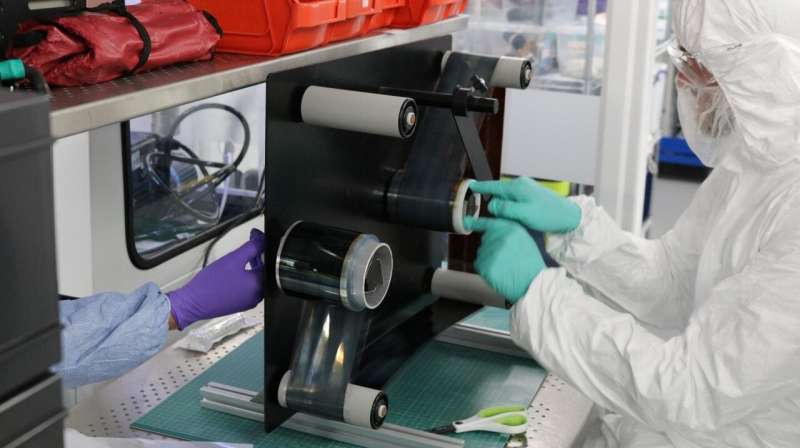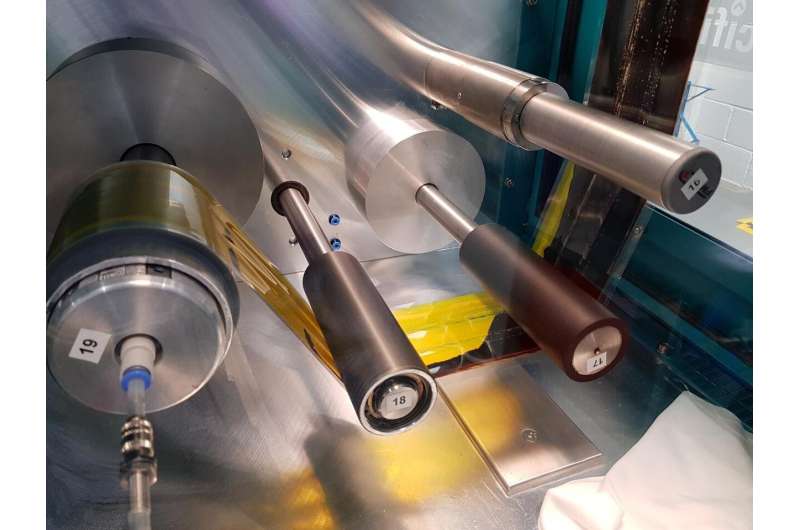Record efficiency for printed solar cells

A new study reports the highest efficiency ever recorded for full roll-to-roll printed perovskite solar cells (PSCs), marking a key step on the way to cheaper and more efficient ways of generating solar energy.
A team at Swansea University's SPECIFIC Innovation and Knowledge Centre, led by Professor Trystan Watson, has reported using a roll-to-roll fabrication method for four layers of slot-die coated PSCs.
The PSCs gave the stable power output of 12.2% - the highest efficiency recorded for four layers of roll-to-roll printed PSCs to date.
A newcomer to the photovoltaic industry, PSCs have gathered remarkable attention from researchers around the globe. With efficiency reaching similar levels to those of silicon photovoltaics (PV), the current market leader, attention has been diverted towards upscaling PSCs.
In contrast to silicon PV, which requires high temperature and high vacuum depositions, PSCs can be solution-processed at a low temperature, which significantly reduces the manufacturing cost.
Low temperature processing makes it possible to use plastic substrates to create flexible solar cells.
The ability to solution-process provides the opportunity to apply various well-developed printing and coating techniques:
- Screen printing
- Inkjet printing
- Gravure printing
- Slot-die coating
- Spray coating

These advantages made it possible for Swansea University researchers to use roll-to-roll manufacturing for four layers of PSCs.
Slot-die coating provides several advantages over the alternatives: it is a pre-metred technique, which means the wet film thickness can be controlled before coating. It is also highly efficient in material usage, with minimal loss of material compared with spray coating or screen printing.
Using the necessary toxic solvents at an industrial scale requires a lot of air handling to stay under the safety limits, which can incur significant and unnecessary expenses. For this reason, an acetonitrile-based system was used. This system has a rheological advantage due to low viscosity and low surface tension, which results in better coatings.
Along with this, a ternary blend of high workplace exposure limit solvents was introduced, replacing chlorobenzene for the deposition of hole transport material. In this research, the PSCs gave the stable power output of 12.2%, which is the highest efficiency reported for four layers of roll-to-roll printed PSCs.
A complete solar cell for a chosen architecture requires coating five layers. In this case, four layers were coated using slot-die coating and the top contact was put on using thermal evaporation. Slot-die coating the fifth (top) contact without destroying any layers underneath has not yet been achieved. Solving this would enable the manufacture of a fully roll-to-roll printed PSC.
Rahul Patidar of SPECIFIC, lead researcher on the project, said, "Perovskite solar cells aim to increase the efficiency and lower the cost of traditional solar energy generation. They have the potential to be highly efficient and relatively cheap to manufacture, so the aim is to improve fabrication methods for upscaling. This study signifies the next step towards commercialisation."
The research was published in Sustainable Energy and Fuels.


















